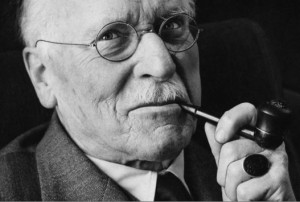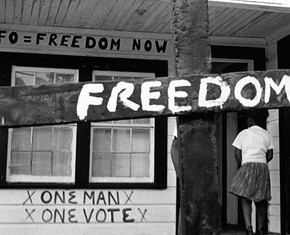The views expressed in our content reflect individual perspectives and do not represent the authoritative views of the Baha'i Faith.
In War and Peace, Tolstoy wrote “The subject of history is the life of peoples and mankind”—in other words, the mass of individuals, not great men, make history.
The pioneering psychologist and philosopher C.G. Jung had the same basic idea:
In the last analysis, the essential thing is the life of individual. This alone makes history, here alone do the great transformations take place, and the whole future, the whole history of the world, ultimately springs as a gigantic summation from these hidden source in individuals.

Carl Jung
After the Great Man theory of history started to fade, by the late 1800s and early 1900s, a counter-theory began to prevail, initially called “history from below.” This new idea, still highly influential in university history departments and across the field of history today, emphasizes the legions over the leaders, maintaining that the daily life of ordinary people really drives history.
Called “people’s history,” the concept focuses on the common people, the outsiders, the mass grassroots movements, and the influence of the poor and the oppressed on the directions human civilization ultimately takes. Its most influential and widely-read historian, Howard Zinn, wrote A People’s History of the United States and a series of similar books. He agreed with the 19th-Century historian Herbert Spencer, who said that the impact and actions of so-called “great men” would be impossible without the influence of the larger social movements that took place long before their reigns. In the last interview before his death in 2010, Zinn said he would like to be remembered for:
… introducing a different way of thinking about the world, about war, about human rights, about equality… for getting more people to realize that the power which rests so far in the hands of people with wealth and guns, that the power ultimately rests in people themselves and that they can use it. At certain points in history, they have used it. Black people in the South used it. People in the women’s movement used it. People in the anti-war movement used it. People in other countries who have overthrown tyrannies have used it.
If you’ve ever read Tolstoy’s War and Peace, you’ve already encountered this major debate between the Great Man Theory and People’s History. Tolstoy, famous for his sympathy for the common people in Czarist Russia, criticized the “Great Man Theory” by saying “A king is history’s slave.” Zinn’s thesis—that history is the story of the exploitation of the majority by the “elite minority”—goes against many conventional approaches to history. So if your sympathies tend to favor commoners over kings, you might be tempted to side with Tolstoy and Spencer and Zinn and believe in the fundamental idea behind people’s history—that the common people make history.
Today major controversies still rage over these widely-differing interpretations and theories of history. Those in the U.S. with a decidedly patriotic inclination, for example, have protested when schools use Zinn’s A People’s History to teach their children about the bloody genocide of Native Americans by European settlers and colonizers. People’s history, which attempts to tell the story of civilization from the perspective of the oppressed and the underdog, often generates an adverse reaction among those who learned their history in a more traditional way. Some say that conventional histories tell the story from the point of view of the conquerors; while people’s histories tell it from the point of view of the conquered.
But peoples’ history is now ascendant in academia and elsewhere, so it has attracted a fair amount of legitimate critical reaction, as well. Critics say the people’s history approach is one-sided and overly simplistic, that it is slanted, has insufficient nuance and assigns good-guy/bad-guy roles respectively to common folks and the so-called “elites,” blaming the elites for everything wrong in society.
Still, people’s history has already had a profound impact on the way we tend to look at the past. Slave narratives, labor struggles, women’s issues and antiwar movements have all made powerful inroads in many societies, changing the way we regard history itself. Rather than trusting academics and professional historians to define what is important and what is not, many modern students of history say that first-person accounts from people who lived through the historical periods in question should be given more credence and attention.
From an objective standpoint, however, we all know that people aren’t perfect—that we have prejudices and partisan disputes and have continued to suffer from them all throughout history. The Baha’i teachings, while they exalt the role of individual human beings in moving the progress of the world forward, also call out the enormous obstacles to peace and harmony that our prejudices have caused and continue to cause.
Abdu’l-Baha spoke about this gruesome trail of war and conflict and identified its chief cause more than a hundred years ago:
When we review history from the beginning of human existence to the present age in which we live, it is evident all war and conflict, bloodshed and battle, every form of sedition has been due to some form of prejudice—whether religious, racial or national—to partisan bias and selfish prejudice of some sort. Even today we witness an upheaval in the Balkans, a war of religious prejudice. Some years ago when I was living in Rumelia, war broke out among the religious peoples. There was no attitude of justice or equity whatever amongst them. They pillaged the properties of each other, burning each others’ homes and houses, slaughtering men, women and children, imagining that such warfare and bloodshed was the means of drawing near to God. This clearly proved that prejudice is a destroyer of the foundations of the world of humanity, whereas religion was meant to be the cause of fellowship and agreement. – Abdu’l-Baha, The Promulgation of Universal Peace, pp. 343-344.
People’s history, then, despite its many important contributions to our understanding of the past, suffers from the same problem that traditional history does—it relies on individual human interpretation of events and trends, which are rarely free of prejudices. That’s why many historians have moved to other, larger explanations for the development of human civilization—and we’ll look at those theories in the next two installments of this series.
















Comments
Sign in or create an account
Continue with Googleor